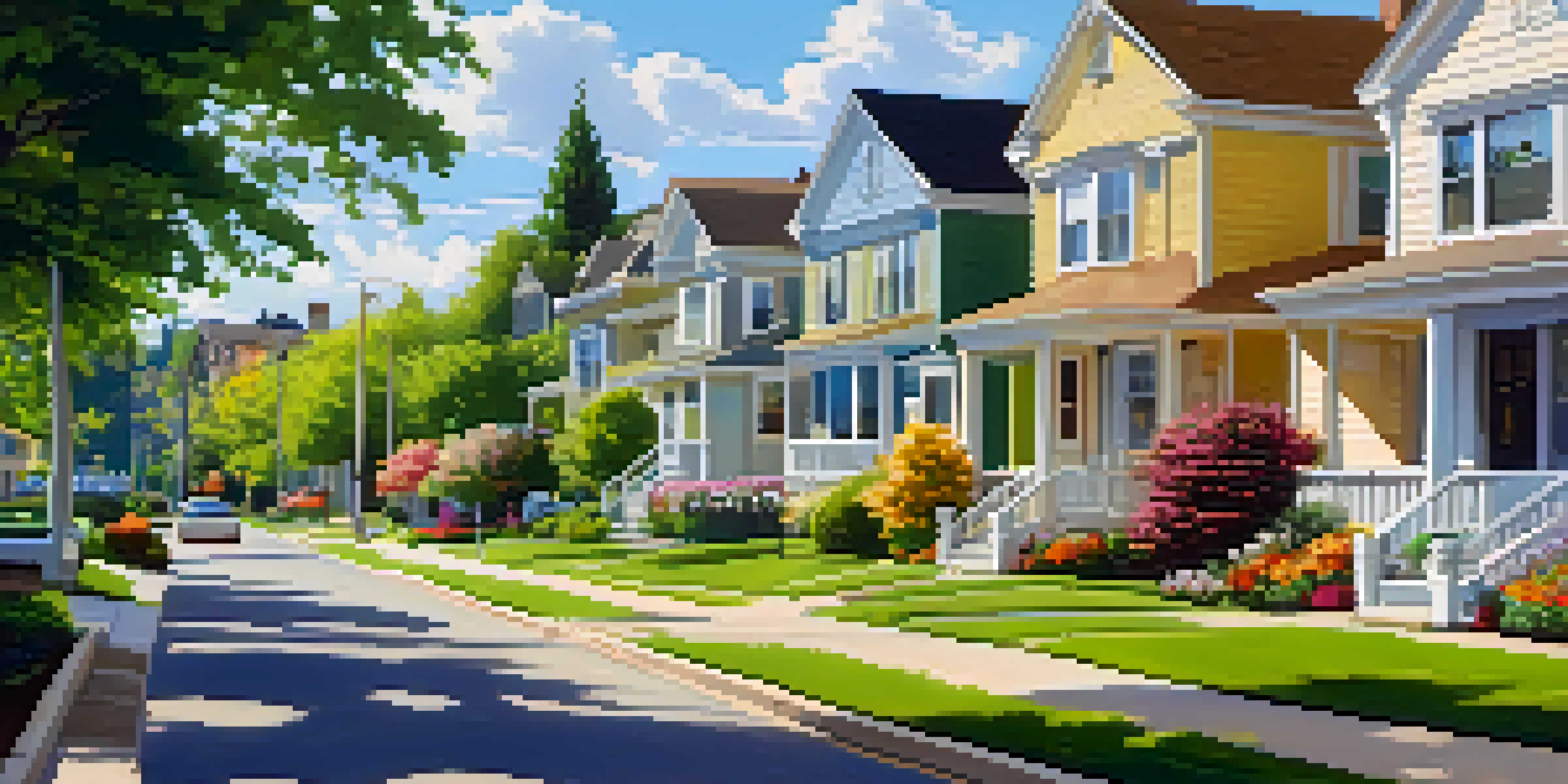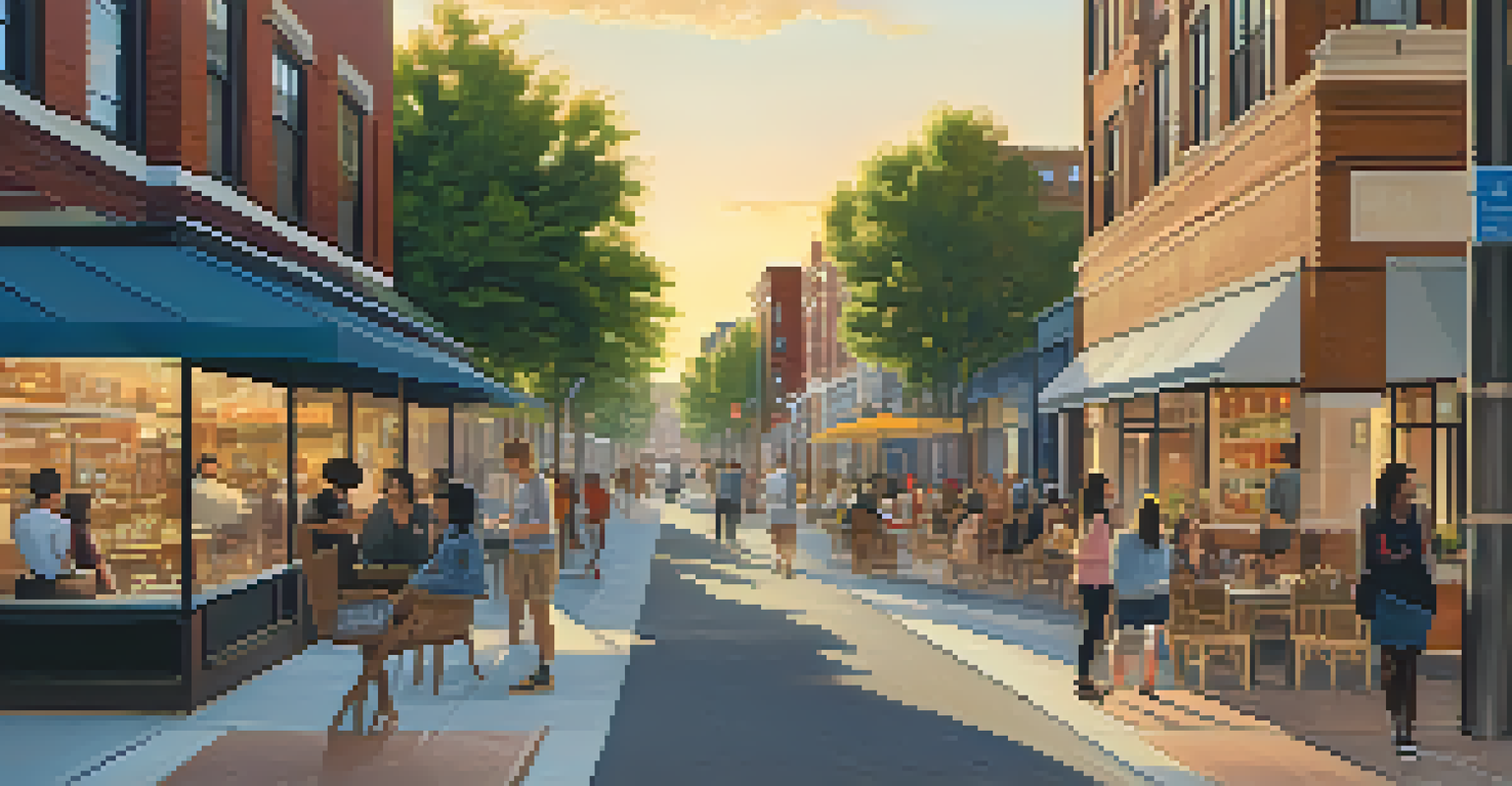Zoning Laws and Their Influence on Neighborhood Development

Understanding Zoning Laws: A Community's Blueprint
Zoning laws serve as the framework that dictates how land can be used in different areas. They categorize land into zones, such as residential, commercial, or industrial, which helps to organize community development. By establishing clear guidelines, these laws aim to create a harmonious balance between various types of land use.
Zoning is a tool for creating a community that reflects the needs and desires of its residents.
For example, a residential zone might prohibit factories from operating nearby, ensuring that families can live in a peaceful environment. This thoughtful planning not only enhances the quality of life for residents but also preserves property values. Without zoning laws, a community could experience chaotic development, leading to conflicts among land users.
Ultimately, understanding zoning laws is crucial for local residents and developers alike. These regulations shape not just the physical landscape but also the social dynamics of neighborhoods. As communities grow, these laws must adapt to meet the changing needs of their populations.
The Role of Zoning in Community Development
Zoning laws play a pivotal role in community development by guiding the type and density of construction allowed in specific areas. For instance, a city may designate certain areas for high-density apartment buildings while reserving others for single-family homes. This careful planning helps ensure that neighborhoods can accommodate diverse populations without overcrowding.

Moreover, zoning can influence local economies by attracting businesses that fit the community's character. If a town wants to promote small shops, it can create mixed-use zones that blend residential and commercial spaces. This not only boosts local economies but also fosters a sense of community as residents can shop and socialize close to home.
Zoning Shapes Community Development
Zoning laws guide land use and construction density, influencing how neighborhoods grow and maintain character.
However, the challenge lies in balancing growth with community needs. While some residents may welcome new developments, others might resist changes that affect their way of life. It’s essential for community members to engage in discussions about zoning to ensure their voices are heard.
How Zoning Affects Property Values
Property values are heavily influenced by zoning regulations, which can either enhance or diminish a property's worth. For instance, areas designated for commercial use often see higher property values due to increased demand for business locations. Conversely, residential zones that limit development may maintain a quiet atmosphere, appealing to families and individuals seeking serenity.
Good zoning is vital for sustainable development, balancing growth with the preservation of community character.
Additionally, zoning can create exclusivity in neighborhoods, with certain areas becoming highly desirable due to their regulations. For example, a neighborhood with strict zoning laws that protect green spaces and historical homes can attract buyers willing to pay a premium. This phenomenon demonstrates how zoning not only affects current property owners but also shapes future investments.
However, it's essential to recognize that over-regulation can lead to stagnation. If zoning laws become too restrictive, they may deter potential buyers and investors. Striking the right balance is key to fostering a healthy real estate market.
Zoning Laws and Environmental Considerations
Zoning laws also play a significant role in environmental conservation and sustainability. By designating green spaces and parks, cities can protect natural resources and promote biodiversity. For instance, zoning regulations may require developers to set aside a portion of land for public parks, ensuring that residents have access to nature.
Moreover, zoning can promote sustainable building practices by encouraging mixed-use developments that reduce the need for transportation. When homes, workplaces, and services are located close together, residents can walk or bike instead of relying on cars, which lowers carbon emissions. This kind of strategic planning fosters a healthier environment for everyone.
Zoning Impacts Property Values
Zoning regulations can enhance or diminish property values by determining the desirability of different areas.
However, zoning laws can sometimes conflict with environmental goals. In areas where development is prioritized, green spaces might be sacrificed. It’s crucial for policymakers to consider environmental impacts when drafting zoning regulations to ensure they promote both development and sustainability.
The Impact of Zoning on Community Diversity
Zoning laws can significantly influence the diversity of communities by dictating who can live where. For instance, restrictive zoning practices, such as large lot sizes, can make housing unaffordable for lower-income families. This can lead to homogenous neighborhoods and a lack of diversity in community experiences.
On the flip side, inclusive zoning policies that allow for affordable housing can enhance diversity within neighborhoods. By incorporating various housing types, such as duplexes and multi-family units, cities can create vibrant, mixed-income communities. These diverse environments foster social connections and broader perspectives among residents.
However, achieving diversity through zoning requires intentional planning and community input. Policymakers must work collaboratively with residents to identify their needs and envision inclusive neighborhoods. This way, zoning can serve as a tool for unity rather than division.
Zoning Laws: A Tool for Disaster Resilience
Zoning laws can also be a vital tool in building disaster resilience within communities. By regulating land use in flood-prone areas, for example, cities can prevent construction in high-risk zones, reducing the potential for damage during natural disasters. This proactive approach helps safeguard lives and property.
Another aspect is the promotion of green infrastructure through zoning. By encouraging the development of permeable surfaces and green roofs, cities can enhance stormwater management and reduce flooding risks. These measures not only protect communities but also create more enjoyable living environments.
Zoning for Environmental Sustainability
Well-crafted zoning laws promote green spaces and sustainable practices, balancing development with environmental protection.
However, it’s essential for communities to remain vigilant and adaptable. As climate change continues to pose new challenges, zoning laws must evolve to address emerging risks. Ongoing dialogue between local governments and residents is crucial to ensure that zoning practices remain relevant and effective.
The Future of Zoning Laws: Challenges and Innovations
As we look toward the future, zoning laws face a myriad of challenges and opportunities for innovation. Rapid urbanization and changing demographics are prompting cities to rethink traditional zoning practices. Many are exploring flexible zoning regulations that allow for adaptive reuse of buildings and mixed-use developments to meet evolving community needs.
Additionally, technology is playing a significant role in shaping the future of zoning. Smart city initiatives are integrating data-driven decision-making into zoning practices, enabling more efficient planning and resource allocation. This innovation can lead to more responsive zoning laws that align with the desires of the community.

However, the path forward is not without obstacles. Balancing the interests of developers, residents, and environmental advocates can be complex. By fostering open communication and collaboration, communities can navigate these challenges and create zoning laws that truly reflect their values and aspirations.